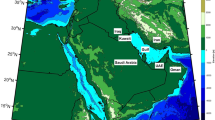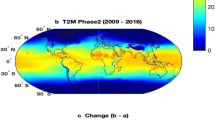Abstract
Given the importance of climate for society at different scales, such as local, regional, and global scales, the analysis of trends of climatic elements improves the assessment of projections and variations, aiding in the design of policies focused on processes of adaptation to and mitigation of the effects of climate change. The aim of this study was to detect mean air temperature trends in the Sertão Paraibano mesoregion in Brazil by constructing temperature series with observed data provided by the Brazilian National Institute of Meteorology (INMET) collected in the localities of Patos and São Gonçalo and with data estimated using Estima_T software to study the spatial and temporal distribution of the mean air temperature of seven localities in the Sertão Paraibano mesoregion: Água Branca, Aguiar, Coremas, Patos, Princesa Isabel, São Gonçalo, and Teixeira. The temperature series with observed and estimated data were compared, showing the variability of using temperature estimates to overcome the lack of meteorological stations in the study area. Descriptive analysis shows low data dispersion in relation to the annual mean values and, therefore, low variability. The monthly mean temperature pattern was similar in all localities and December was always the warmest month, whereas July was the coldest, both in the estimated and observed data series. The non-parametric Mann-Kendall test indicated that estimated series show trends of significant increases in mean air temperature, in annual, biannual, quarterly, and monthly periods, in all localities. Sen’s slope results indicate significant increases in temperature from 0.008 to 0.011 °C/year.








Similar content being viewed by others
References
Abrahão, R., Peixoto, I. M. B. M., Silva, L. P., Medeiros, S. E. L. (2017). Mais calor para o Sertão? Perspectivas de tendências no índice de calor do Sertão Paraibano. In: Congresso Brasileiro de Agrometeorologia, 20.
AESA – Agência Executiva de Gestão das Águas do estado da Paraíba, 2009. Plano Estadual de Recursos Hídricos – Relatório final. http://www.aesa.pb.gov.br/perh/. Accessed 25 Aug 2017.
Barry, R. G., & Chorley, R. J. (2009). Atmosphere, weather and climate. London and New York: Routledge.
Blain, G. C. (2010). Séries anuais de temperatura máxima média do ar no estado de São Paulo: variações e tendências climáticas. Revista Brasileira de Meteorologia, 25(1), 114–124.
Cavalcanti, E. P., Silva, V. P. R., & Sousa, F. A. S. (2006). Programa computacional para a estimativa da temperatura do ar para a região Nordeste do Brasil. Revista Brasileira de Engenharia Agrícola e Ambiental, 10(1), 140–147.
Cetin, M. (2015a). Determining the bioclimatic comfort in Kastamonu City. Environmental Monitoring and Assessment, 187(10), 640.
Cetin, M. (2015b). Using GIS analysis to assess urban green space in terms of accessibility: case study in Kutahya. International Journal of Sustainable Development & World Ecology, 22(5), 420–424.
Cetin, M., Adiguzel, F., Kaya, O., & Sahap, A. (2018a). Mapping of bioclimatic comfort for potential planning using GIS in Aydin. Environment, Development and Sustainability, 20(1), 361–375.
Cetin, M., Zeren, I., Sevik, H., Cakir, C., & Akpinar, H. (2018b). A study on the determination of the natural park’s sustainable tourism potential. Environmental Monitoring and Assessment, 190(3), 167.
El Kenawy, A., López-Moreno, J. I., & Vicente-Serrano, S. M. (2012). Trend and variability of surface air temperature in northeastern Spain (1920–2006): linkage to atmospheric circulation. Atmospheric Research, 106, 159–180.
Goossens, C., & Berger, A. (1986). Annual and seasonal climatic variations over the northern hemisphere and Europe during the last century. Annales geophysicae. Series B. Terrestrial and Planetary Physics, 4(4), 385–399.
IBGE – Brazilian Institute of Geography and Statistics (Instituto Brasileiro de Geografia e Estatística) (2010). Resultados do Censo Demográfico. http://www.ibge.gov.br/home/estatistica/populacao/censo2010/caracteristicas_da_populacao/caracteristicas_da_populacao_tab_municipios_zip_xls.shtm. Accessed 30 May 2017.
INMET – National Institute of Meteorology (Instituto Nacional de Meteorologia). (2017). Banco de dados meteorológicos para o ensino e pesquisa. www.inmet.gov.br/ portal/index.php?r=bdmep/bdmep. Accessed 01 Jul 2017.
IPCC – Intergovernmental Panel in Climate Change. (2013). Climate Change 2013: The physical science basis. Contribution of working group I to the fifth assessment report of the intergovernmental panel on climate change. Edited by T. F. Stocker et al., New York: Cambridge University Press.
IPCC – Intergovernmental Panel in Climate Change. 2014. Impacts, adaptation, and vulnerability. Contribution of working group II to the fifth assessment report of the intergovernmental panel on climate change. Edited by C. B. Field et al., New York: Cambridge University Press.
Jones, P. D., New, M., Parker, D. E., Martin, S., & Rigor, I. G. (1999). Surface air temperature and its changes over the past 150 years. Reviews of Geophysics, 37(2), 173–199.
Kendall, M. G. (1975). Rank correlation methods. London: Charles Griffin.
Li, B., Chen, Y., Shi, X., Chen, Z., & Li, W. (2013). Temperature and precipitation changes in different environments in the arid region of northwest China. Theoretical and Applied Climatology, 112, 589–596.
Lima, R. A. F. A., Menezes, H. E. A., & Brito, J. I. B. (2010). Diagnóstico de tendência de mudanças na temperatura do ar no nordeste setentrional. Revista Caatinga, 23, 2.
Mann, H. B. (1945). Nonparametric tests against trend. Econometric. The Econometric Society, 13, 245–259.
Marengo, J. A., Rusticucci, M., Penalba, O., & Renom, M. (2010). An intercomparison of observed and simulated extreme rainfall and temperature events during the last half of the twentieth century: part 2: historical trends. Climatic Change, 98(3), 509–529.
Modares, R., & Silva, V. P. R. (2007). Trends analysis of rainfall record in arid and semi-arid regions of Iran. Journal of Arid Environments, 70(1), 344–355.
NOAA – National Oceanic & Atmospheric Administration. Heat index. 2016. http://www.srh.noaa.gov/ama/?n=heatindex. Accessed 26 sep. 2017.
Obregon, G. O., Marengo, J. A. (2007). Caracterização do clima no século XX no Brasil: tendência de chuvas e temperaturas médias e extremas. Relatório n° 2 – Projeto: Mudanças Climáticas Globais e Efeitos sobre a Biodiversidade – subprojeto: Caracterização do clima atual e definição das alterações climáticas para o território brasileiro ao longo do século XX.
PBMC – Brazilian Panel on Climate Change (Painel Brasileiro de Mudanças Climáticas). (2014). Base Científica das Mudanças Climáticas. Contribuição do Grupo de Trabalho 1 do Painel Brasileiro de Mudanças Climáticas ao Primeiro Relatório de Avaliação Nacional sobre Mudanças Climáticas. Ambrizzi, T., Araujo, M. (Eds.). Rio de Janeiro.
Salmi, T. A. M., Anttila, P., Ruoho-Airola, T., & Amnell, T. (2002). Detecting trends of annual values of atmospheric pollutants by the Mann-Kendall test and Den’s slope estimates-the Excel template application MAKESENS. Air. Qualitative Research, 7–35.
Santos, C. D., Dantas, L. G., Melo, M. M. M. S., & Santos, E. D. (2012). Trends in indices for extremes in daily precipitation over Idaho-USA. Revista Brasileira de Geografia Física, 4, 852–862.
Sen, P. K. (1968). Estimates of the regression coefficient based on Kendall’s tau. Journal of the American Statistical Association, 63, 1379–1389.
Silva, V. P. R., Cavalcanti, E. P., Braga, C. C., Azevedo, P. V. (2007). Evaluating trends in solar radiation based on data fields from the NCEP/NACR reanalysis and measurements, 7th EMS Annual Meeting/8th ECAM. El Escorial, Madrid Anais. Madrid: European Meteorological Society.
Sneyers, R. (1992). On the use of statistical analysis for the objective determination of climatic change. Meteorologische Zeitschrift, 1, 247–256.
Viney, N. R., & Bates, B. C. (2004). It never rains on Sunday: the prevalence and implications of untagged multi-day rainfall accumulations in the Australian high quality data set. International Journal of Climatology, 24, 1171–1192.
Yucedag, C, Kaya, L.G., Cetin, M., 2018. Identifying and assessing environmental awareness of hotel and restaurant employees’ attitudes in the Amasra District of Bartin. Environmental Monitoring and Assessment, 2018, 190(2), 60.
Funding
This work was supported by the National Council for Scientific and Technological Development (CNPq) under projects 305419/2015-3 and 401687/2016-3.
Author information
Authors and Affiliations
Corresponding author
Additional information
Publisher’s Note
Springer Nature remains neutral with regard to jurisdictional claims in published maps and institutional affiliations.
Rights and permissions
About this article
Cite this article
Medeiros, S.E.L., Abrahão, R., da Silva, L.P. et al. Comparison between observed and estimated data to assess air temperature variability and trends in the Sertão Paraibano mesoregion (Brazil). Environ Monit Assess 191, 63 (2019). https://doi.org/10.1007/s10661-019-7207-8
Received:
Accepted:
Published:
DOI: https://doi.org/10.1007/s10661-019-7207-8




